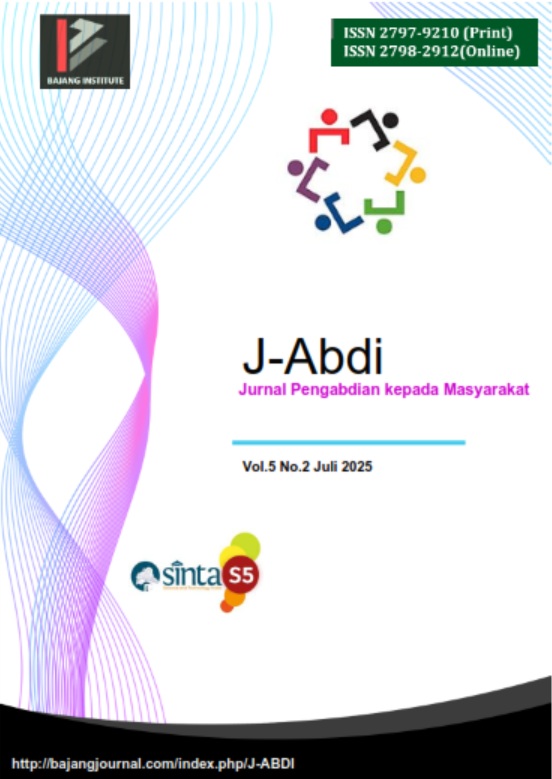PENGABDIAN MASYARAKAT PEMBELAJARAN BUDAYA DI SMA KARANGPANDAN, KARANGANYAR PADA ERA DIGITAL
DOI:
https://doi.org/10.53625/jabdi.v5i2.10861Keywords:
community service, learning, digital, cultural education, teacher trainingAbstract
Community service in the form of cultural learning using digital technology represents a significant innovation in education, especially in the modern era where teaching methods must adapt to technological advancements. This program was implemented at SMA Karangpandan, Karanganyar, to address the issue of student disengagement and boredom with traditional, monotonous learning methods. The community service team, consisting of lecturers from various academic backgrounds such as culture, language, elementary education, and health, provided training and guidance to teachers to enhance their digital teaching skills. The program introduced various digital learning methods, including podcasts, online community-based learning, adaptive learning, e-learning platforms, webinars, augmented reality (AR), virtual reality (VR), and digital resources such as e-books. The results showed a significant improvement: prior to the program, only 20% of teachers utilized digital methods, but this increased to 75% after the intervention. The pre-test and post-test results demonstrated a marked increase in teachers’ abilities to integrate digital technology into their teaching. This community service initiative successfully contributed to the advancement of digital-based learning, making the educational process more engaging and relevant to the needs of today’s students.
References
Adams, E. Kathleen, Nancy Breen, and Peter J. Joski. “Impact of the National Breast and Cervical Cancer Early Detection Program on Mammography and Pap Test Utilization among White, Hispanic, and African American Women: 1996–2000.” Cancer 109, no. S2 (January 15, 2007): 348–358.
Dian Rianita, Alexsander Yandra, Khuriyatul Husna, Adia Ferizko. Upgrading Teachers’ Professionalism through Class Observation-based-Publication Training. Dinamisia : Jurnal Pengabdian Kepada Masyarakat. 2023 May 4;7(2).
Prestridge S, Jacobsen M, Mulla S, Paredes SG, Charania A. New alignments for the digital age: insights into connected learning. Educational Technology Research and Development [Internet]. 2021;69(4):1–16. Available from: https://link.springer.com/content/pdf/10.1007/s11423-021-09968-5.pdf
Riowati R, Yoenanto NH. Peran Guru Penggerak pada Merdeka Belajar untuk Memperbaiki Mutu Pendidikan di Indonesia. Journal of Education and Instruction (JOEAI). 2022 Jan 18;5(1):1–16.
Santika S, Savitri Y. Foreign language learning in the digital age: theory and pedagogy for developing literacies. Educ Rev (Birm). 2022;75(4):807–8.
Salmerón L, Delgado P. Critical analysis of the effects of the digital technologies on reading and learning / Análisis crítico sobre los efectos de las tecnologías digitales en la lectura y el aprendizaje. Cultura Y Educacion. 2019;31(3):465–80.
Tran T, Ho MT, Pham TH, Nguyen M, Nguyen KLKLP, Vuong TT, et al. How digital natives learn and thrive in the digital age: Evidence from an emerging economy.
Sustainability [Internet]. 2020;12(9):3819. Available from: https://philpapers.org/archive/TRAHDN.pdf
Kırkgöz Y. Twelve tips for co-production of online learning. Med Teach. 2023;1–6.
Dziubaniuk O, Ivanova-Gongne M, Nyholm M. Learning and teaching sustainable business in the digital era: a connectivism theory approach. International journal of educational technology in higher education [Internet]. 2023;20(1). Available from: https://educationaltechnologyjournal.springeropen.com/counter/pdf/10.1186/s4 1239-02300390-w
Feng H, Wang J. Learning in a Digital World: Perspective on Interactive Technologies for Formal and Informal Education. Interactive Learning Environments. 2021;1–4.Allcoat D, Hatchard T, Azmat F, Stansfield KE, Watson DG, Mühlenen A von. Education in the Digital Age: Learning Experience in Virtual and Mixed














